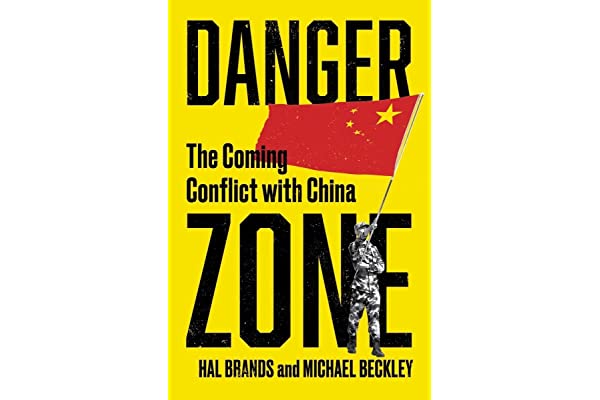Book review: Danger Zone – The Coming Conflict with China by Hal Brands and Michael Beckley offers a very scary road map for US victory in the new imperialist Cold War
Adam N Lee, chinaworker.info
Brands and Beckley, specialists in geopolitical history, present their book Danger Zone as “a contrarian take” on China’s global power and the new Cold War between Washington and Beijing. China is already in decline, they argue, and has therefore fallen into “the peaking power trap”. Rather than breathing a sigh of relief, they insist this makes China an even more dangerous threat to US interests. “For more than a decade, China has been concealing a serious economic slowdown that existentially threatens the ruling regime”, they say. We can agree on this point, while much of the book is extremely disagreeable.
Socialists and chinaworker.info have consistently made the case, certainly since the Xi Jinping era began, that the economic foundations of the Chinese dictatorship are significantly weaker than claimed.
On China’s demographic crisis the book points out, “From 2020 to 2035, China will lose roughly 70 million working-age adults and gain 130 million senior citizens. That’s a France-sized population of young workers, consumers, and taxpayers gone – and a Japan-sized population of elderly pensioners gained – in just fifteen years”.
Brands and Beckley cite the examples of Imperial Germany in 1914 and Japan in 1941 – powers that had similarly begun to decline. This is of course an oversimplified and one-sided view of what caused WW1 and WW2. But the book throughout is unabashedly one-sided. These historical comparisons are offered to convey the idea that Beijing’s current trajectory impels it to “start” a war.
In reality, despite Xi Jinping’s nationalistic wolf warrior-style diplomacy, his dictatorship’s primary concern is keeping control of China’s 1.4 billion people. For Brands and Beckley, rather than ease off the pressure, China’s current unmistakeable crisis means the US must further escalate its Cold War strategy.
“Split the Internet”
The authors argue the decade of the 2020s is the period of most acute US-China rivalry, including the risk of war. The book opens with a hypothetical Chinese invasion of Taiwan in 2025, including a surprise attack on the US Pacific Fleet, timed to coincide with a bitterly contested power transition following the next US presidential election. This decade is therefore the “danger zone” of the book’s title.
The danger they are sounding is not to avoid war, but for US imperialism to take urgent steps to prepare and insure it comes out on top. The main theme of the book is summed up in the following passage: “Americans urgently need to start seeing the Sino-American rivalry less as a 100-year marathon and more a blistering, decade-long sprint. That’s because China will be a falling power far sooner than most people think.”
This is a book written for the US political elite – these are the “Americans” the authors talk about. Based on the actual policy of the last two to three years, we see that much of what Brands and Beckley advocate already corresponds to mainstream opinion within the US ruling class and the policies of the Biden administration.
What strategy do they advocate? The authors support big increases in US and Western military spending, for a strategic focus on Taiwan as the key to controlling East Asia, and “to reestablish a free-world economic bloc, this time aimed at China”. Rather than wholesale deglobalization they argue for “a strategic, multilateral decoupling in the technologies and resources that matter most.”
In October, the Biden administration announced unprecedented export controls that will – if fully enforced – cut China off from the world’s most advanced semiconductors. This is a potentially crippling blow to the Chinese economy. The book, published two months before this policy came into effect, anticipates and calls for just this type of aggressive technological warfare. It floats the idea that the US and its allies could “preemptively split the Internet” creating a digital bloc that would exclude China and other authoritarian regimes.
Brands and Beckley want the US Cold War strategy to “prioritize ruthlessly”. The tech war alongside Taiwan are seen as top priorities. While Washington shouldn’t ignore other areas, it “must focus on issues where the dangers are acute and the consequences of failure would be felt for decades”. The key for the authors is what the Pentagon has identified as “critical technologies” – which of course directly links to Taiwan, where 90 percent of the world’s most advanced semiconductors are made.
Belt and Road
Accordingly, on China’s grandiose infrastructure plan, the Belt and Road Initiative (BRI), the authors take a more relaxed view than many other Western commentators. The book cautions the US government not to “counter every Chinese infrastructure project around the world”, which anyway would cost too much. Last year, the G7 (bloc of the richest capitalist economies) launched an alternative to China’s BRI, pledging US$600 billion for infrastructure projects in the neo-colonial world. While the authors don’t mention this, and so far the G7 initiative has achieved very little, clearly they think this is not the right direction to take.
“If Beijing wants to spend lavishly on white elephant infrastructure projects in some of the roughest neighborhoods in the world… so be it,” they reason. In reality, the Chinese regime has been cutting back significantly on the BRI since 2018. Economically it has become more of an albatross than a symbol of China’s global power. This is an example of imperial overreach by Xi Jinping’s dictatorship which socialists and chinaworker.info predicted when the BRI was officially launched in 2013.
“More than half of China’s Belt and Road partners have credit ratings below investment grade. The Chinese government itself has estimated it will lose 80 percent of the value of its investments in South Asia, 50 percent in Southeast Asia, and 30 percent in Central Asia,” the book explains.
There are many fallacious ideas in the book. It is taken as self-evident that China is the power that threatens, while the US is playing defence. There is also the repeated assertion that the US stands for democracy. But Brands and Beckley partly refute this nonsense themselves. They say the US must be pragmatic and cooperate with “imperfect democracies and even a few friendly non-democracies”. Of course, we know this has always been a hallmark of US imperialism’s foreign policy. Biden’s battle against “autocracy” offers US military and economic support to Erdogan, El Sisi, Prayut and countless other autocratic rulers.
Socialists understand the crucial difference of basic democratic rights and the existence of independent workers’ organisations in bourgeois democracies such as the US, compared to dictatorships where these rights don’t exist. That makes workers’ struggle much more difficult and dangerous. But we also understand that neither of the camps in the new Cold War defend workers’ rights beyond occasional empty words. Neither Washington or Beijing want workers to organise and fight. In 2022, Biden’s government outlawed a national strike by rail workers – how very “Chinese”!
It is on Taiwan that the authors are the most hawkish. They advocate a bigger and faster military build-up by the US and its allies to forestall a Chinese invasion. Their timescale for possible war is a matter of years not decades. Again, the authors base this on an assessment that the Chinese regime is getting weaker, meaning an attack could be launched out of desperation. This view is not particularly contrarian. Secretary of State Blinken claimed last year that China wants to take over Taiwan on a “much faster timeline” than previously thought. Admiral Philip Davidson, former head of the US Indo-Pacific Command, was widely quoted predicting a Chinese invasion by 2027.
This scenario is not completely excluded. But behind Xi Jinping’s Taiwan bluster, there are important indications Beijing actually wants to avoid or postpone this conflict. Its main concern is to preserve the current precarious status quo and avoid any action that could signal its permanent “loss” of Taiwan, such as a formal proclamation of Taiwanese independence. Again, the book presents a very one-sided (pro-US) perspective that evades the very real danger that the US itself provokes, whether intentionally or not, a Chinese attack by crossing one or more of Beijing’s red lines. One such might be a decision to base US troops on the island, something the authors favour.
Saving Taiwan?
Taiwan is critical to US global power projection, because it is “the center of gravity in East Asia”. Should the Chinese regime win a Taiwan war it would gain “an unsinkable aircraft carrier” allowing it to “project power into the Pacific, blockade Japan and the Philippines, and fracture US alliances in East Asia.” Here they let slip that for both Cold War camps the conflict has nothing to do with the wishes of the Taiwanese people or their right to self-determination.
In a section misnamed “saving Taiwan” they say the US and Taiwan governments aren’t moving fast enough to strengthen militarily, although they also point out the Pentagon has put Taiwan “at the center of US defense strategy”. They support making Taiwan a US treaty ally, through a security agreement – a move that in itself could trigger war. But this would not be enough they argue, unless backed up by a major US militarisation drive in the Taiwan Strait by stationing missiles, drones, and other weapons on “allied territory near the strait”.
Brands and Beckley have no answers other than to accelerate an already dangerous Cold War conflict. Socialists explain that both the US and Chinese capitalist regimes are responsible for placing the entire planet in the “danger zone” of a possible worldwide military conflagration. This book offers a peephole into the strategic deliberations of the class enemy. The conclusions are terrifying and underline why it is urgent to build an international socialist alternative to capitalism and imperialism.




